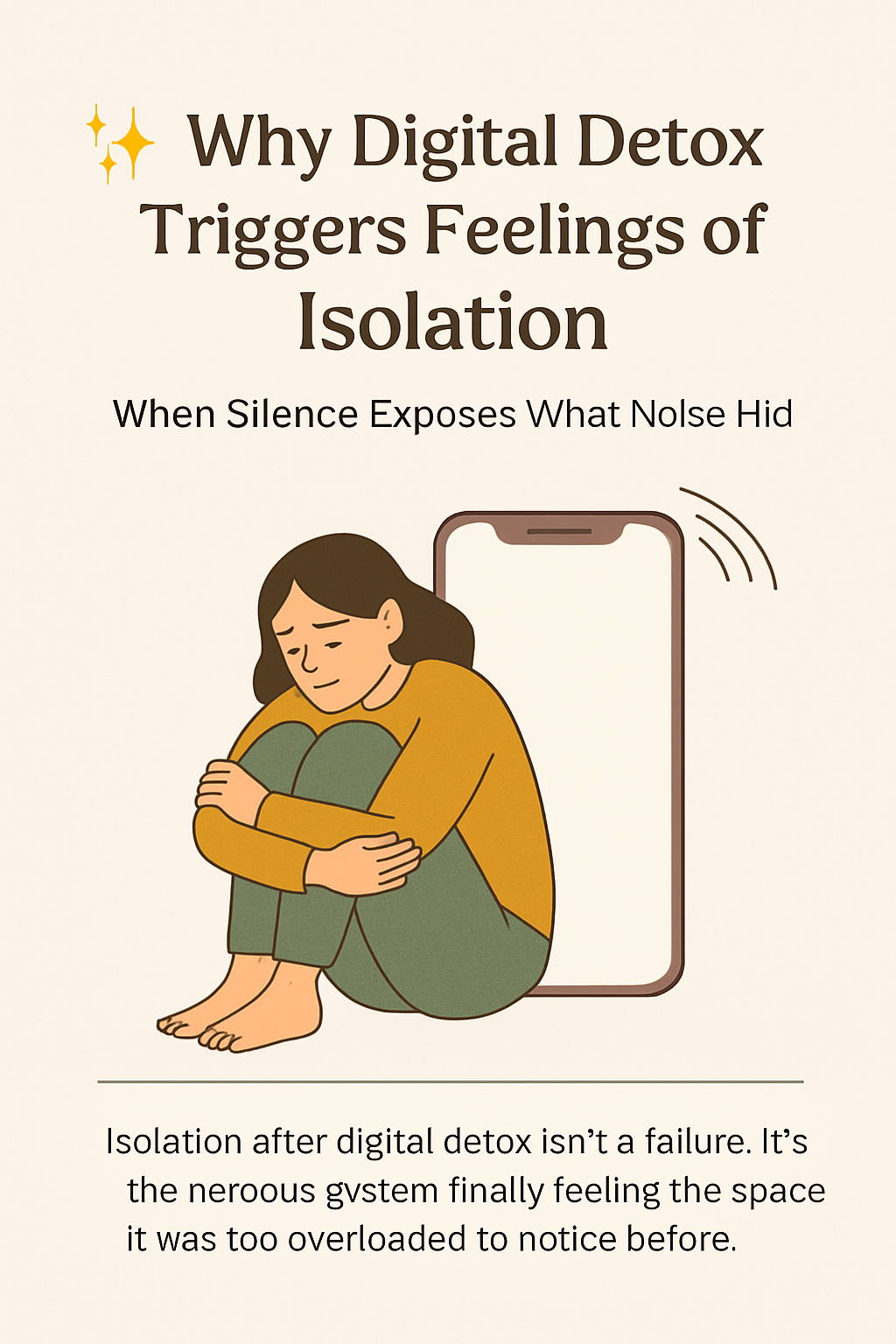
🧠 When Silence Exposes What Noise Hid
Isolation after digital detox isn’t a failure.
It’s the nervous system finally feeling the space it was too overloaded to notice before.
Let’s begin.
🌟 I. “The Silence Was Louder Than I Expected”
When you imagined stepping away from screens, you pictured:
- Peace.
- Calmness.
- Mental clarity.
You dreamed of:
- Quiet mornings.
- Unrushed evenings.
- A heart that beats more slowly, more kindly.
But when the noise stopped,
something else surged up instead:
- A hollow ache.
- A heavy silence.
- A loneliness that sat too big, too loud, right inside your chest.
You wondered:
- “Wasn’t I supposed to feel better?”
- “Why does everything feel so much heavier now?”
- “Did I make a mistake pulling away?”
But here’s the tender truth:
You didn’t create the isolation.
You uncovered it.
The constant buzz of digital life didn’t heal the loneliness inside you —
it numbed it.
Without the scrolling, clicking, posting, consuming…
you finally created enough stillness to hear what had been waiting inside you all along:
- A hunger for real connection.
- A longing for real presence.
- A nervous system ready to heal — but first, ready to grieve.🌿
🧠 II. Why Digital Detox Triggers Emotional Isolation
🧬 Tech Overload Gave False Signals of Connection
Every:
- Like
- Comment
- Notification
- Message
acted like a tiny emotional “ping.”
It told your nervous system:
- “You’re seen.”
- “You’re included.”
- “You matter.”
Even if it wasn’t real.
Even if:
- You weren’t truly known.
- You weren’t truly connected.
- You weren’t truly held.
The brain, desperate for belonging, accepted the illusion.
And when you strip it away?
- The hollowness underneath is revealed.
- The ache that was always there rises.
- The real hunger for community becomes undeniable.
If you want a full guide on how to move through post-detox loneliness and rebuild real connection in a safe, sustainable way, you can explore The Loneliness After Digital Detox: Why It Happens and How to Heal. 🌿
🛡️ Removing Artificial Stimulation Exposes Emotional Gaps
Screens gave you:
- Constant noise
- Endless novelty
- Fleeting touchpoints
But they rarely gave you:
- Deep resonance
- Soulful belonging
- Nervous system co-regulation
When you detox:
- The nervous system no longer gets “false safety signals.”
- It starts asking for real, embodied, slow connection.
- Emotional hunger surfaces — and it feels raw, big, overwhelming.
This isn’t failure.
It’s your body’s first honest conversation with you in a long, long time.
🔄 The Nervous System Feels Exposed and Vulnerable
Without:
- Scrolling distractions
- Rapid novelty dopamine
- Digital performance validation
your nervous system is suddenly:
- Naked.
- Raw.
- Asking for presence — not performance.
At first, this feels like unbearable loneliness.
But in truth?
It’s the birthplace of authentic reconnection — the sacred ground real belonging can grow from.🌿
🌱 III. Healing Blueprint: How to Understand and Move Through Isolation After Digital Detox
Loneliness isn’t a mistake to fix.
It’s a threshold — a doorway you step through, slowly, toward something more real.
Here’s how you begin:
🌿 1. Recognize Isolation as Nervous System Awakening
You’re not suddenly “more alone” after detox.
You’re finally more awake.
- Awake to emotional needs that were drowned out by noise.
- Awake to relational hunger that shallow pings couldn’t satisfy.
- Awake to your nervous system’s true longing for real-world safety, touch, and resonance.
The ache you feel isn’t regression.
It’s awareness.
Awareness is uncomfortable.
But it’s always the first step toward genuine healing.
📖 2. Resist the Urge to Re-Overstimulate
The temptation will rise:
- Reinstall the apps.
- Open a dozen tabs.
- Fill the silence with quick, easy noise.
Don’t shame yourself for feeling that urge.
But know this:
- Running back to stimulation doesn’t erase loneliness.
- It just buries it deeper again.
Sit with hunger.
Stay in the silence a little longer than feels comfortable.
Every second you stay, you strengthen your nervous system’s tolerance for real presence.
🌸 3. Create Slow Emotional Bridges
You don’t need to throw yourself into instant new communities.
You need to build tiny emotional bridges:
- Make eye contact with the cashier.
- Smile at a neighbor.
- Say hello to someone at the park.
Tiny moments of human acknowledgment:
- Re-anchor your nervous system.
- Remind your emotional body it belongs.
It’s not about deep connection immediately.
It’s about reintroducing yourself to the real rhythm of human life — gently, tenderly, consistently.
🧘♀️ 4. Strengthen Self-Connection as a Foundation
Before you can reconnect deeply with others,
you have to reconnect with yourself.
Daily rituals for self-connection:
- Journaling what you’re noticing — without judgment.
- Breathwork (inhale for 4, exhale for 8) to calm and reset.
- Grounding through touch (place a hand over your heart or your belly and simply breathe).
Self-connection repairs:
- Emotional safety
- Inner anchoring
- Trust that you can exist without constant external validation
🌄 5. Trust That Belonging is Being Rebuilt the Right Way
The ache you feel?
- It’s your longing to wake up.
- It’s your humanity resurfacing.
- It’s your nervous system asking for real resonance — not simulations.
Trust it.
The depth of your loneliness today
is the exact depth of belonging you are now preparing to build tomorrow.🌿
🧠 Bonus Support: Therapy for Isolation, Connection, and Nervous System Healing
If the isolation feels unbearable sometimes —
please know, you are not meant to heal alone.
Professional CBT-based therapy can help you:
- Build real-world relational safety
- Heal emotional abandonment wounds
- Strengthen nervous system resilience for deep belonging
We recommend Online-Therapy.com, a trusted CBT platform specializing in emotional reconnection, trauma healing, and resilience cultivation.
💡 Use code THERAPY20 to get 20% off your first month. Online-Therapy.com🌿
You don’t have to rush.
You don’t have to force.
You only have to stay present long enough for real life to find you again.
📚 IV. FAQ Section: Isolation After Digital Detox
❓ Why do I feel isolated after a digital detox?
Because without shallow digital stimulation, your nervous system becomes aware of deeper, unmet needs for real, slow, embodied connection.
❓ Is feeling isolated a sign that I shouldn’t have detoxed?
Not at all.
It’s a sacred part of healing.
The silence reveals what needs to be honored, rebuilt, and truly held — not numbed again.
❓ How long does post-detox isolation typically last?
Most experience waves of emotional isolation during the first 2–4 weeks.
With slow real-world reconnection, it gradually softens into belonging.
❓ How can I ease the loneliness without rushing back to screens?
- Focus on tiny human moments (smiling, saying hello)
- Strengthen self-connection rituals
- Trust that real community builds slowly but securely
🌿 “The Silence Didn’t Break Me — It Began to Build Me”
When I first deleted the apps, silenced the feeds, and stepped back from the noise —
I thought freedom would feel light.
Instead, it felt like standing barefoot on raw ground after years of walking on padded floors.
Unsteady. Exposed.
Painfully aware of every emptiness I had been too busy to notice.
There were mornings I almost gave in —
not because I missed the content,
but because I missed the feeling of not feeling so alone.
“The silence didn’t break me.
It simply peeled away every false comfort,
until I could finally hear my own soul asking for something real.”
If you are sitting inside that heavy quiet right now,
please know: it’s not the end.
It’s the beginning.
Stay.
Stay with the ache, the hunger, the trembling stillness.
The life you were always meant for is growing roots beneath your feet even now —
even here —
even when it feels impossibly far away.
